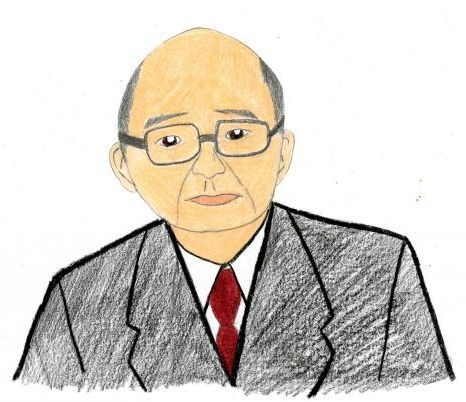 |
| Soichiro Honda (Hand-drawn Picture) |
Many will know his last name, but first name, probably not. Soichiro Honda, born on November 17, 1906 in the small Japanese village of Tenryu, had always dreamed about the incredible vehicles, cars. His mother worked with cloth and his father was a blacksmith who made iron into tools. He helped his father cut charcoal for fire in the shop. One day, a man drove by his town in a Ford Model T. Soichiro was fascinated by the moving vehicle and even stuck his hands into the oil puddle that had been left by the car. That was the start of his car craze.
Soichiro was not the greatest in academics. He didn’t understand things taught in books, but mechanics he did understand. Soichiro moved to Tokyo, the largest city of Japan, at the age of fifteen. He worked in a garage where the owner, who was also a mechanic, fixed American cars. The owner did not trust Soichiro and would not let him touch the cars that he was working on. Soichiro wasn’t happy with the owner’s decision for him to only sweep the floor and was about to quit. But then, he had the idea of sweeping the floor until it was spotless and maybe then the owner would be impressed and show him how cars worked. Soichiro worked hard and the owner finally recognized his effort and dedication. After about a year or so, the owner finally started to teach Soichiro how to repair cars.
The owner trained Soichiro as a mechanic for six entire years. He learned to fix every part of a car, including the carburetor and transmission. Soichiro then decided to open his own shop in Hamamatsu, a city close to his hometown. His garage opened in 1928 and he became an expert auto mechanic. His shop repaired nearly every car in the city.
Soichiro made a lot of money from his garage shop and married Sachi, a schoolteacher. Honda started designing race cars because he loved to drive fast. In 1936, he built and then drove the fastest race car of Japan and became the champion racer of his country. Before long, he was injured in an accident, which caused his wife to persuade him to stop racing.
Honda didn’t stop dreaming about making cars though. He then started to manufacture metal piston rings that moved up and down in a car’s engine and converted energy in gas into force that helps turn the car. At first, Honda thought that making piston rings was easy, but he was proven wrong. His first tries were unsuccessful, for the rings were easily breakable. He went back to school to study metallurgy and to learn how to work with metal. Soichiro tried many times before he perfected the rings in 1940. He sold them to Toyota, one of the first car companies of Japan.
During World War 2, Honda was asked to make propellers for airplanes. After the war was over, the Japanese could not afford cars because they lost in the war. Honda was daunted, but he was still able to make a living through repairing old vehicles. Gas for cars was very costly after the war, so Soichiro rode the train every day. He loathed traveling on the crowded train, but riding his bicycle was too slow. So, Honda combined the bicycle’s structure and the car’s motor to create a mini low-cost motorcycle. This interested and impressed local businessman Takeo Fujisawa, who built a motorcycle factory. Honda and Fujisawa then teamed up and established the Honda Motor Company. Soichiro continued to improve motorcycle motors to make them more powerful and get more gasoline mileage for the same price.
Honda was very precise about his motorcycles. He wanted them to be perfect, so when he yelled at his associates, or workers, he was nicknamed “Mr. Thunder.” Although he shouted at his workers, he treated them fairly and included them in new ideas. He would even let them keep the money they made with their new invention. Honda then began to dominate America’s motorcycle industry with his brand new Super Cub motorcycles in 1959.
When Soichiro Honda went back to the car industry, he started shipping middle-sized cars. Tadashi Kume helped prevent the terrible mistake of having air-cooled engines rather than water-cooled engines. He convinced Honda to change his decision and Soichiro was glad. In 1972, the Honda Civic arrived in the U.S. It was a very "green" car and helped the environment. During that time, gas went up dramatically in price. People liked the Civic for getting double the mileage than American cars. Sales were good.
At the age of sixty-six, Soichiro Honda retired and left the younger associates in charge of company. He was still a director of the company and enjoyed his retirement. He died at the age of eighty-four on August 5, 1991.
Soichiro Honda is my hero because he never, ever gave up his dream of manufacturing cars. He also loved to create new things, like I do. His perseverance and determination inspire me to do my best and to achieve my goals. I hope to have better willpower and drive, like Soichiro Honda, my hero.
Page created on 3/21/2015 2:44:26 PM
Last edited 9/19/2024 8:57:24 PM
